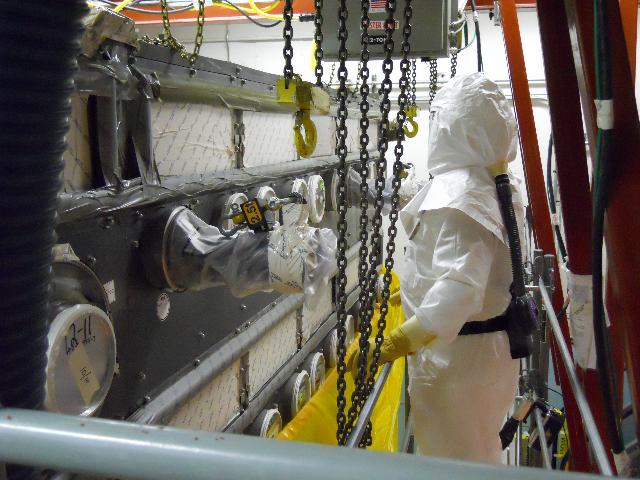
The House of Representatives’ fiscal 2020 Energy and Water appropriations bill that contains the budget for the Department of Energy will include about 4% more funding than the enacted 2019 bill, according to spending limits published Tuesday by the House Appropriations Committee.
The total allocation for the 2020 energy and water development appropriations bill, which funds DOE and other federal agencies, will be just under $46.5 billion, compared with slightly over $44.5 billion for the current fiscal year ending Sept. 30.
The Energy Department budget — including funding for nuclear-weapon stockpile operations, cleanup of legacy nuclear sites, and civilian nuclear waste management — accounts for most of the annual Energy and Water Development appropriations bill. In 2019, DOE’s roughly $34.5-million budget was more than 75% of the total spending level, by funding.
The Appropriations energy and water subcommittee allocation does not specify how much money appropriators will propose spending in 2020 on the various DOE nuclear programs. The subcommittee will decide funding levels in a markup that had yet to be scheduled at deadline Friday for Weapons Complex Monitor.
The Senate Appropriations Committee has not yet issued its version of the spending allocations.
The Donald Trump administration in March requested that Congress cut DOE’s 2020 budget by about 10% from the current enacted level, to $31.7 billion. The White House’s 2020 budget slashed certain discretionary spending programs — the category that includes all federal programs except mandatory social safety nets — to keep their budgets level with spending limits that apply to the next fiscal year’s budget.
In a budget hearing Thursday, House Energy and Commerce energy subcommittee Chairman Bobby Rush (D-Ill.) told Energy Secretary Rick Perry that a number of reductions in his agency’s proposal are “nonstarters.” That is in line with Congress’ response to the initial DOE budget plan for the current fiscal 2019, which at $30.6 billion came in well below the final enacted level.
The latest DOE budget plan “includes extreme reductions to some critical programs: federal investments in clean energy programs, power grid operations, next-gen energy technologies, and economic development for tribal communities,” Rush said. Other committee members affirmed that they would not let select proposals proceed, including elimination of the Advanced Research Projects Agency–Energy.
For the Environmental Management office’s national portfolio of Cold War nuclear remediation projects, the White House requested a 10% cut for fiscal 2020, from about $7.2 billion to less than $6.5 billion.
House Energy and Commerce Chairman Frank Pallone (D-N.J.) called the DOE proposal “essentially dead on arrival,” emphasizing several areas including legacy nuclear site cleanup.
The Energy Department’s environmental liability for those 16 contaminated properties has grown to $377 billion, the large majority of DOE’s overall $494 billion liability as of fiscal 2018, according to the Government Accountability Office. That situation was highlighted in a hearing last week of the House Energy and Commerce oversight and investigations subcommittee.
“The GAO highlighted serious mismanagement at these sites and included the department’s mounting environmental liabilities on its high-risk list,” Pallone told Perry. “Now, I recognize this is a problem you did not create, Mr. Secretary, unfortunately the president’s budget makes your job more daunting by cutting the Environmental Management program by over $700 million from last year’s level.”
Subcommittee member Cathy McMorris Rodgers (R-Wash.) later pressed Perry to discuss what should be done to complete environmental remediation at the Hanford Site in her state. The former Manhattan Project and Cold War plutonium production site is the largest and most complex of EM’s cleanup programs.
The Energy Department’s 2019 Hanford Lifecycle Scope, Schedule and Cost Report in January projected the remaining expense for remediation and starting long-term stewardship of the site at $323 billion to $677 billion, and said work could continue beyond this century. It found that $4 billion in annual cleanup funding, to start, would be needed beginning in fiscal 2020.
For fiscal 2020, which begins Oct. 1, DOE is seeking $2.1 billion for Hanford. That would be a $400 million reduction from current funding levels. Congress also went beyond the DOE request for Hanford funding in fiscal 2019.
“I think we’re making some pretty darn good progress out there,” Perry said, citing the anticipated announcement this fall of completion of cleanup of the final reactor in the Columbia River Basin.
The Energy Department is more than halfway through shipping around 24 containers of sludge from Hanford’s K West Reactor to the T Plant. Once the sludge is removed. the reactor basin can be extracted and Hanford’s final two reactors placed into interim safe storage.
Perry acknowledged, though, that full cleanup at Hanford will take “a long time, it’s going to cost a hell of a lot of money.”